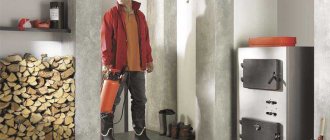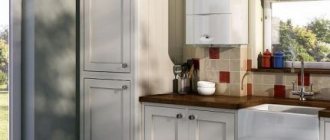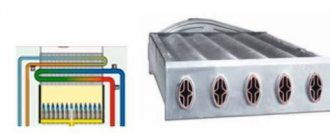Boiler
(English boiler - boiler) - a water heating device in the heat and hot water supply system [1].
As a rule, in Russian, “boiler” is assumed to be something different from a boiler, although there are other opinions [2]. According to the Rules for the Design and Safe Operation of Steam Boilers, a boiler
is a synonym for the word
water heater
: “a device heated by steam or hot water, used to heat water under pressure above atmospheric.”
Accordingly, a boiler-boiler
is a steam boiler in the drum of which there is a device for heating water used outside the boiler itself, or in the natural circulation of which a separate boiler is included during operation.
At thermal power plants, nuclear power plants and some boiler houses, boilers are network heaters in which the heating network water is heated by steam from turbine extractions or from steam boilers. The room where they stand is called the boiler room
[1] .
In everyday life, a boiler is often called any water heater: an indirect heating boiler (heating fluid obtained from a local boiler or heating network), an electric water heater and even a gas water heater.
Relatively recently, electric kettles with boiler mode and thermopots have appeared, in which a constant water temperature is maintained, sufficient for brewing tea or coffee.
Everyone has heard the word “boiler room” in one way or another; most people consider it ordinary and familiar. And this is the majority who answer the question - what is this? - answers: “Well, the boiler room is...” Indeed, not everyone can answer such a seemingly simple question right off the bat. Let's try to figure it out together.
What is a boiler room
Boiler installation - what is it and for what needs is it used? Logic dictates that the boiler room is the room where the boiler is located. It is a container for heating liquid.
Simply put, a boiler is a steel tank in which liquid for the domestic hot water system is heated in any way.
The point is not to deliver hot water from a thermal power plant to a residential area, but to raise its temperature right on the spot, thereby eliminating the inevitable heat losses during transportation.
Some houses do not have hot water supply at all, and the boiler system is the only source of hot water for them. In addition to the heaters themselves, other equipment is also needed - feed pumps, shut-off valves, control unit, measuring instruments, etc.
Boiler prices
Principle of operation
How does an instantaneous water heater work? A stream of water passes through a relatively small product, heating it to the desired temperature. The heating element is used of a standard type or in the form of a heating coil. In volumetric devices, the first option is always used, and in miniature ones, the second option, because there is simply nowhere to insert the heating element.
As soon as the tap opens, the heating element turns on, the water flow heats up, and when the tap is closed, the power supply to the product is turned off. The principle of operation of an instantaneous water heater is based on the fact that the temperature of the water flow set by the user is gained in a short time, and then only with the help of the heating element is kept constant. Externally, an ordinary electric instantaneous water heater looks like a small plastic container with a connection to the home water supply.
When an instantaneous electric water heater is used as a separate hot water tap, its operating principle becomes even simpler: the water flow is instantly heated by a powerful spiral enclosed in a copper housing.
Why do you need a boiler room?
A boiler room is needed to provide hot water to the residents of the house. The heating process can be carried out in various ways, which are selected depending on the availability of a heat source, or the greatest economic benefit from using the type of heating.
In an apartment building
In apartment buildings, the heat source is hot water (or steam) from the central heating system (CH). A boiler in an apartment building has the same purpose as in any other place, but from a design point of view it is somewhat different from other types, being an ordinary heat exchanger. The principle of its operation is simple: hot water from the central heating system (coolant) is passed through a container, inside of which there is a pipe system that does not communicate with the internal volume of this container. Cold liquid flows through them, which is heated by the coolant and sent to the domestic hot water system. That is, the coolant is used not only for heating rooms, it also provides the availability of hot water.
In a private house
In a private house that does not have a connection to the central heating system, the boiler performs the function of heating the liquid using heat from the boiler . Fuel can be electricity, gas, firewood, coal, briquettes, etc.
In this case, the term “boiler” is used according to tradition, but not entirely correctly. The exact name of such a device is a boiler, and the room for it, accordingly, is a boiler room. If there is a connection to the central heating system, then you can install a heat exchanger, but this possibility is still rare in rural areas.
DIY water heater installation
Diagram of the connected water heater.
Instantaneous water heaters are much easier to install yourself than storage water heaters. To do this, you just need to install a special machine and lay a powerful three-core cable directly from the switchboard. Installation is carried out in 2 options:
run the cable under the baseboard or groove the wall, and after laying the cable, seal it with cement or putty.
From the tool you may need:
- perforator;
- screwdriver;
- drill;
- spanners;
- pliers.
Installing a storage water heater with your own hands can take from 2 to several hours. First you need to calculate exactly how much tank volume you will need. This must be done to understand exactly how the water heater should be mounted.
Thus, tanks with a volume of up to 100 liters can be hung on the wall, but with a volume of more than 150 liters they must be placed on the floor.
According to the rules, the tank of a storage-type water heater must be located at least 30 cm above the floor. The most convenient mounting location in the apartment is above the toilet in the toilet.
Water heater design diagram.
Everyone chooses the specific height themselves, based on their height and the height of their family members. Installation of such a water heater may require several people (at least 2).
Tanks are supplied for sale with the necessary fastenings: anchor bolts - 2 or 4, depending on the type of water heater.
- Therefore, when installing it yourself, first be sure to attach the anchors to the wall according to the instructions. The required distance, if not specified, is calculated from the notch on the rear of the tank.
- The main thing to remember when installing a storage water heater with your own hands is that the wall must be load-bearing. If the wall crumbles when drilling, you need to take longer anchors.
- When a tank is not secured securely, there is a high probability of its collapse. Who wants to change the toilet with their own hands? So the installation should begin with checking the complete configuration of the storage water heater.
Connection diagram of the cold water line to the water heater.
Storage water heaters have 2 special outputs: red and blue. This is for cold and hot water respectively. The included safety valve is attached to the blue hole. It is necessary for the proper operation of the water heater: this valve is responsible for releasing excess pressure in the tank.
2 special ball shut-off valves are attached to the red outlet from the tank and to the check valve of the blue outlet. The tank can be attached to the water pipes and mixer using metal-plastic pipes or using a flexible line of the required length.
If, when installing with your own hands, you decide to go with metal-plastic pipes, you should remember 2 mandatory things:
- You cannot bend such pipes;
- you need to carefully select pipes. Thus, seamed metal-plastic pipes are suitable only for cold water, while seamless pipes are required for hot water.
- If you plan to install and use a flow-through heater in an apartment, then, as noted above, it will require a three-core cable.
- A gas instantaneous water heater is not yet the most common occurrence in a modern apartment. And since you will have to deal with the gas main, it is better to invite a specialist to properly install and connect the gas device.
Whatever option you choose, the main thing will be the uninterrupted availability of hot water, which will undoubtedly make the life of any person much easier.
We study the structure of the boiler: 4 internal elements.
Boiler types
There are different heater designs made for different heat sources or fuel types.
The choice of type is determined by the availability of a certain type of energy or fuel. If there are several options, the most economical option is usually used.
The most common types of heaters are:
- Indirect. The transfer of thermal energy between different media is used.
- Flow-through. The pipe section heats up. Efficiency depends on the flow rate: the higher it is, the less efficient the heater is - the liquid does not have time to heat up to the required temperature. At the same time, you can use such a device immediately, without waiting for the required volume to heat up, and the hot water will never run out.
- Cumulative. Heating a liquid in a container of a certain volume. You can create any pressure - the temperature will not change. But when the tank is empty, you will have to wait for the new volume to heat up, which takes some time.
Boiler design for heating water
The design of the boiler includes elements for heating water, which are divided into the following types:
- Located in water (they are called open or wet).
- Elements that do not have direct contact with water (they are called closed or dry).
Wet water heating elements are quite familiar to us and resemble tubes placed in a kettle. They are hollow and contain a heating coil. Empty space is usually filled with special magnesium oxide or sand. The substance can be anything, the main thing is that it has high heat conductivity.
Dry water heating elements are separated from contact with water by a special ceramic casing.
This type is considered safer due to the following points:
- no scale occurs;
- the risk of a short circuit is practically zero;
- accidentally turning on the device without liquid does not spoil this type of heating elements so much;
- the service life is much longer.
In addition, these elements differ depending on the type of fastening; they are nut and flange. In the second case, pressing occurs with a large number of small bolts.
Types of storage boilers
Storage heaters are divided into two types:
- Open (non-pressure).
- Closed (pressure).
A boiler device for heating open (non-pressure) water consists of a small container of approximately 5-10 liters, equipped with a special mixer that can shut off the water when the device is finished using. The heater does not create pressure and is suitable for use in garden areas for summer showers.
Closed (pressure) heaters can provide hot water to a country house. They have a large capacity - 50-200 liters, are built into the water supply system, and work on the principle of uniform mixing. That is, when hot water is taken, there is no sudden replacement of cold water, but new portions are gradually added, which contributes to a more even supply of hot water to the house.
Varieties
Today, the Russian domestic market offers a very large selection of electric water heaters of different types and types with different price ranges, while the build quality and individual parts can vary greatly. The electric instantaneous water heater has long enjoyed well-deserved popularity among users in different regions of the Russian Federation due to its simple operation. They are divided into two main types:
- pressure or closed type;
- non-pressure - open type.
The first option is capable of supplying hot water to several points at once: a washbasin, a shower stall, a kitchen, but for this it is necessary to ensure a fairly high pressure in the home water supply line.
The second option functions normally at any pressure in the main line with a connection directly to the water intake point.
Boiler room requirements
A boiler room in a private house must meet the requirements of fire safety, ease of operation, repair, and comply with the technical parameters of the equipment. In addition, it is necessary to accommodate a fairly large amount of equipment - the boiler itself, control and monitoring equipment, pumps, etc. All these devices must be installed in accordance with the technical requirements.
The size of the boiler room in a private house must be at least 6 m2, and the volume - at least 15 m3, with a ceiling height of 2.5 m. These requirements are established by the fire inspectorate and must be observed. In addition, such a room is most convenient for servicing or repairing equipment.
Plot
Seth is a guy from a wealthy family whose dad works as a district judge.
Despite a secure future, Seth does not want to follow the path trodden by his father, but dreams of finding his place in life. First, he drops out of college and sets himself a very simple goal - to become rich, earn a lot of money, achieve happiness in his personal life and build a relationship with his father. The film takes place in the 90s, when the world opened up new opportunities for smart people, and a lot of ways for stupid people to part with money.
First, Seth opens an underground casino right in his home, and then goes to an internship at a brokerage company with Jordan Belfort himself.
Is it possible to make a boiler room or boiler room in the basement of a private house?
The question often arises: “Is it possible to make a boiler room in the basement of a house?” To place a boiler room, the basement is the most convenient place, but there are limitations.
The fact is that in SNiPs such an arrangement is directly prohibited, but it must be taken into account that this means boilers running on liquefied hydrocarbon fuel (LPG), which was previously used to power equipment everywhere.
Today, the devices use natural gas, so the ban has been lifted. There are no restrictions for electric boilers.
Features of the boiler video
Having studied the above, you can be sure that the equipment is in good working order and will last for a long time, without causing problems, much less consequences in the form of an explosion of pipes and a tank, which can cause the destruction of an entire room and entail far from small expenses.
4 questions about placing a water heater in the interior.
Choosing a location for a water heater in your home depends on your hot water needs, the layout and size of the room. This is a responsible matter that requires an engineering approach and correct calculations.
1 Floor or wall? If the volume of a storage water heater exceeds 200 liters, it is better to consider a floor-standing option. In such tanks, thicker steel is used and a copper heating element is installed, which is not subject to corrosion. Floor heaters, as a rule, are used in country houses, where both the needs and possibilities (at least in terms of placement) are higher than in a city apartment. Small wall-mounted water heaters with a volume of 50-80 liters are usually installed in apartments to compensate for the shutdown of hot water.
Horizontal or vertical? There is an opinion that in horizontal water heaters the water warms up worse: due to convection, it is warmer at the top than at the bottom. However, experts reassure us that we are talking about fractions of a degree. But the horizontal model can be built into small rooms where it is not possible to place a vertical water heater, and almost anywhere - for example, hung above a doorway. Some manufacturers produce universal water heaters that can be hung both vertically and horizontally. The heating element in such systems is located at an angle, so that the water will warm up evenly in any case.
3 Why is a flat water heater convenient? Another solution to the problem of limited space is to choose a flat-mount water heater, which takes up less space than conventional storage units and is sleeker in appearance. Alas, energy efficiency is often sacrificed for aesthetics: the size of the tank can be reduced due to the thermal insulation layer. To understand whether the tank is sufficiently insulated, place your hand on the body - if it is warm, then the thermal insulation is not working, if it is cold, everything is in order. Good thermal insulation cannot be less than 40 mm thick, and better - from 60 mm.
4 Where to install the water heater? General rule: the distance from the body to the disassembly points (taps) should be minimal. Firstly, it reduces heat loss, and secondly, you will have to wait less for hot water. In a city apartment, the water heater is usually installed in the same room where the disassembly takes place: in the bathroom or kitchen. Another thing is a big house. In this case, the system must be designed by a specialist who will find a location taking into account the layout, calculate the length of the pipes and the required volume of the tank. If water heating is not “tied up” to the operation of boiler equipment, it may be advisable to place the heater in the attic. If the house has boiler rooms where all communications are located, it is also convenient to install a water heater there. It will be out of sight, but at the same time available for preventative maintenance and repair.
Tips and tricks for installing equipment
In addition to specific requirements for installation and connection of equipment, there are general requirements for boiler rooms:
- The walls must be made of brick or concrete.
- Storage of flammable or explosive substances is prohibited.
- A technological gap is required between the equipment and the walls (determined from the equipment passport).
- The ventilation system is calculated based on the boiler power.
- The best finishing option is tiles, but you can use mineral plaster.
- Doors must open outward along the evacuation route.
The installation of a boiler room in a private house must fully comply with the needs of residents and the capabilities of network organizations. In the absence of central heating networks or gas mains, it is possible to create a completely autonomous heating and hot water system, independent of resource or electricity suppliers.
Video on the topic: installation of a boiler room in a private house
Comfortable living in a private house is impossible without such benefits of civilization as hot water and heating. But to get them, you need to put in a lot of effort. Especially if you plan to make your home completely autonomous - in this case, you cannot do without a special boiler room where heating and water storage devices will be located. Proper arrangement of this room is the key not only to properly functioning utility networks, but also to your safety, so we further suggest you figure out what requirements are put forward for the organization of a boiler room: dimensions, norms for equipment placement, connection diagrams - a theoretical assistant and a photo are for your attention.
Some characteristics
So, before you start installing water heating devices with your own hands, you need to figure out which one is right for you in terms of all its characteristics.
Today there are several types of water heaters on the market:
- accumulative;
- electric flow;
- flow gas type.
Of these, each buyer chooses solely according to his preferences. As a rule, a big role is played by how often and how many people will use a particular water heater during the period when hot water is turned off.
If it’s just one person and not very often, then you can install a flow element for yourself. But if at this time there will be 3 or more family members living in the apartment, then the storage accessory will be the best choice.
Boiler room location
First, let's look at the definitions. A boiler room means a technical room with a whole range of special equipment, which is designed to organize hot water supply in the house. In parallel, the same complex is responsible for heating. That is why, taking into account its multifunctionality, it is more appropriate to call the room a boiler room, although both names are common in everyday life. There are three variations in the location of the boiler room.
- The first is inside the house: in the basement or basement, or in a remote room on the first floor.
- The second is in a special extension: the boiler room is built close to the house, mainly from the bathroom side.
Boiler room equipment
The uninterrupted operation of the boiler room, and, accordingly, the provision of hot water and heating to the house, is impossible without a whole set of special devices and communication elements. The mandatory components of the system include:
- The boiler is the main heat generator. It is here that the coolant is heated, which is subsequently supplied to the boiler and heating devices. Based on the source of heat energy, boilers are divided into five types: electric, gas, solid fuel, liquid fuel and combined.
- Boiler – water heater tank. Inside the container there is a tube through which the hot coolant moves - it transfers heat to the water in the boiler, thereby heating it to the required temperature.
- Distribution manifold - pump, hydraulic distributor and comb. This unit ensures the distribution and uninterrupted circulation of the coolant throughout all elements of the working system.
- Hydraulic accumulator - expansion tank: compensates for the increase in pressure during the heating of the working coolant.
- Safety devices - air vent, safety valves, pressure gauge: protect the system from excess air and excess pressure.
- Automation – various kinds of electronic devices that are designed for coordinated control of all components of the heating and water supply system.
- Chimney - outlet pipe: removes the combustion products of working fuel to the external environment. There is no urgent need for a chimney only if an electric boiler is used in the boiler room.
- A set of shut-off valves designed to quickly shut off the flow of coolant in case of emergency situations.
Simple design of a gas boiler
The boiler is controlled by a temperature sensor and thermostat. They are responsible for fixing a certain level of water temperature, and as soon as the heating reaches the desired level, the system automatically turns off. Gas boilers are equipped with a safety group or, in other words, a special safety valve that relieves too high pressure. This prevents the product from exploding and similar consequences. To prevent scale formation on the product, a magnesium anode is also installed in it, which needs to be changed over time, as it is destroyed due to exposure to salts in hard water.
Boilers can be of different types, types, shapes and even installation methods, but the requirements for their purchase are on average the same, since you need:
Inspect the body for integrity; Pay attention to the availability of certificates for compliance with GOST; Buy products only at specialized sales points; Be sure to check the terms of the warranty.
Basic requirements for a boiler room
All requirements for the arrangement of a boiler room can be divided into two categories: those relating to the room itself and the equipment. Let's start with the first ones.
The boiler room must have a large area - at least 6 sq.m. The minimum volume of the room is 15 cubic meters. The ceiling height should be 2.5 m or more. These requirements are determined not only by safety measures, but also by the ease of maintenance of the heating and hot water system - it is important to ensure free access to all pipes and appliances.
The walls of the boiler room are made only of fire-resistant materials - concrete or brick. The floor is made of concrete. For finishing cladding of both walls and floors, it is recommended to use relief tiles. An acceptable alternative for walls is non-combustible mineral plaster. If the boiler room is installed directly in the house or in an extension to it, it must be separated from neighboring residential premises by reflective walls made of material with a zero fire spread limit. The door of the boiler room must be fireproof. It is recommended that it opens outwards.
A ventilation system must be organized in the boiler room. If it is not possible to install special fans, you should take care of natural ventilation - make a 15x20 cm hole in the upper zone of the room.
equipment requirements
When installing equipment in a boiler room, you should remember the following rules:
- There should not be more than two heating boilers in the room.
- The minimum distance between large appliances (boilers and boilers) is 70 cm.
- Neither the heating boiler nor the boiler should be adjacent to the surface of the walls on either side - there must be free space between the appliances and the walls.
- If the boiler room is located on the ground floor of the house, the total power of the system equipment should not exceed 150-200 kW, and if in an extension, in a semi-basement or basement - 350 kW. In the case of boiler rooms in individual buildings, such strict standards are not provided.
- Electrical wiring must be covered. The best option is to hide it in special steel pipes.
- Lamps must be covered with metal mesh housings.
As you can see, the arrangement of a boiler room, or boiler room, in a private house requires compliance with many standards - starting from the dimensions of the technical room and ending with its equipment. Violation of these requirements is fraught with major troubles, so take into account all the nuances if you want to get a truly effective and safe heating and water supply system for your home.
Is it possible to combine a gas boiler room and a bathroom?
The fact that the installation of a gas boiler in bathrooms and toilets is prohibited is stipulated in the document SNiP 2.04.08-87. The document directly prohibits the installation of heating equipment in these premises.
Interesting materials:
How to calculate the amount in Word 2013? How to send a parcel by mail? How to view the viber archive? How to view cookies in Yandex? How to view exchange history? How to view your browsing history in the browser? How to view history in Firefox? How to view history in Internet Explorer 11? How to view history in Viber? How to view Google Chrome cache on Android?











